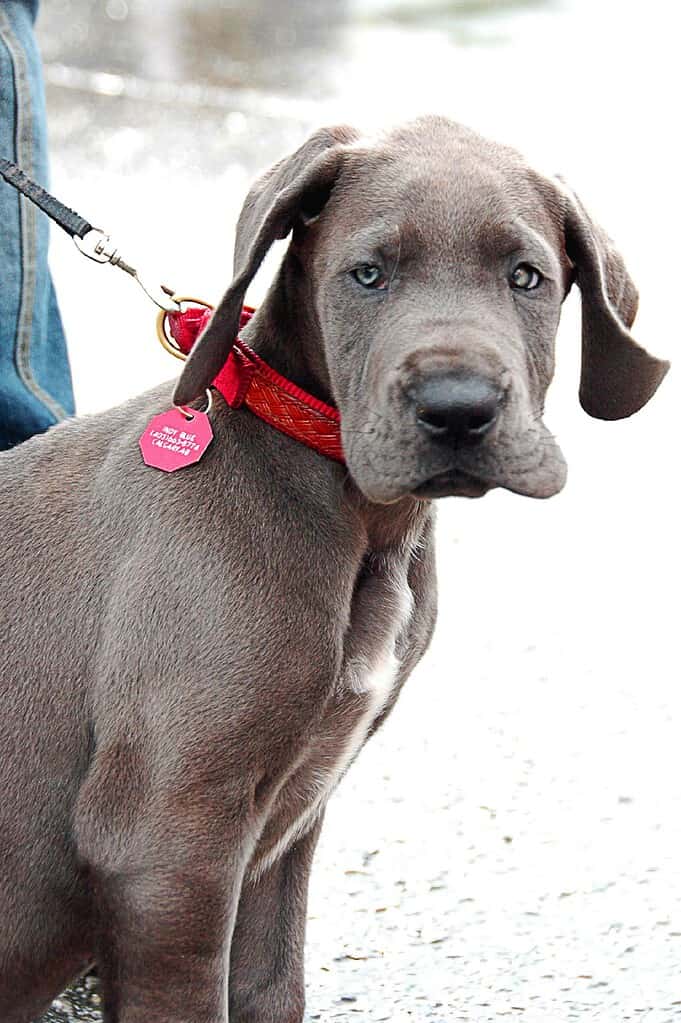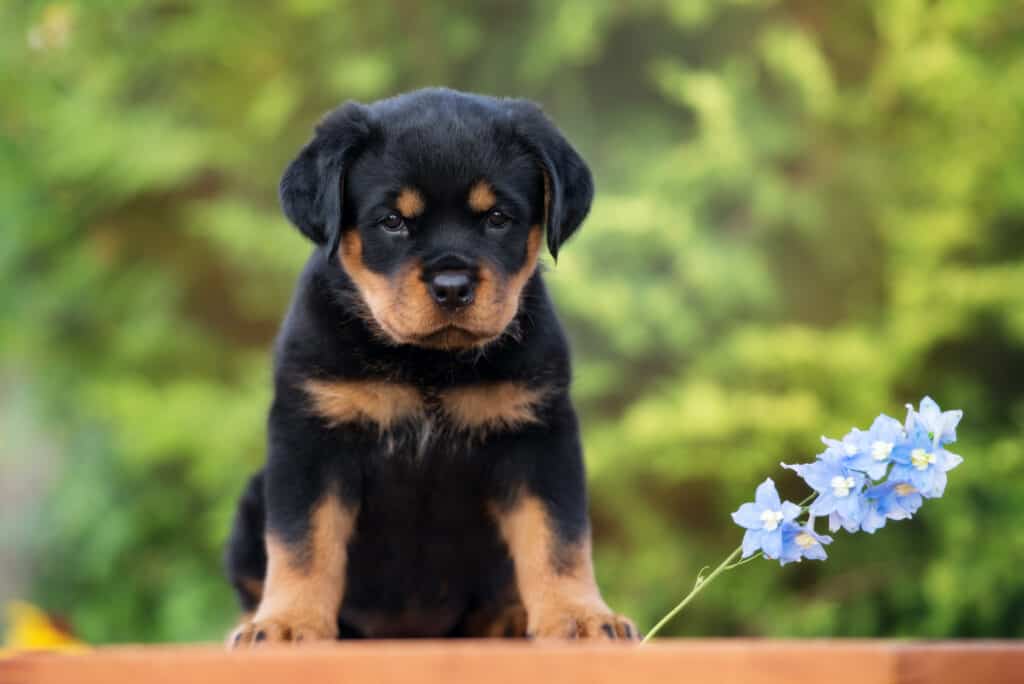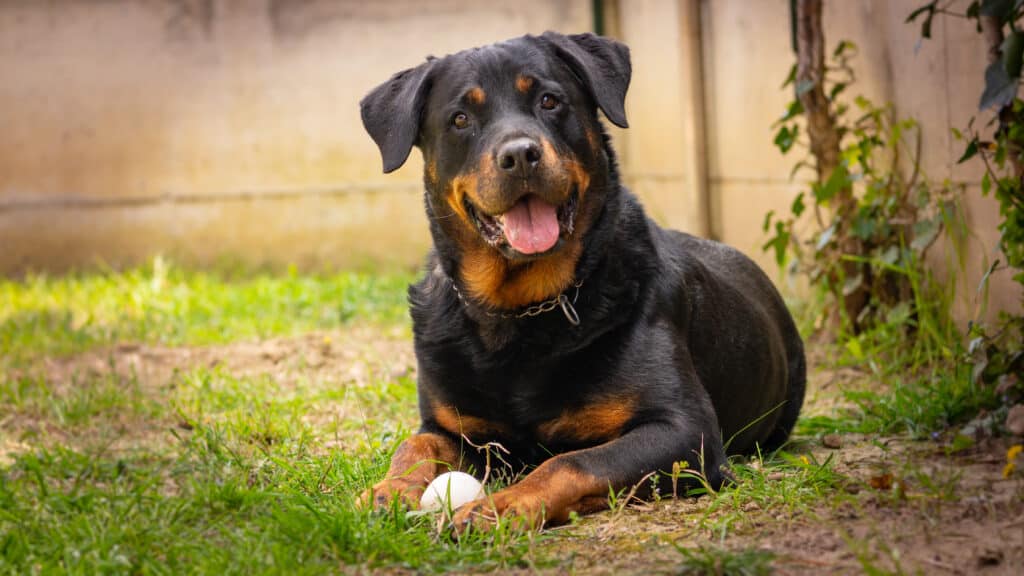Rottweilers, popularly known as “Rotties,” captivate hearts with their robust build, glossy coats, and compelling gaze. As descendants of the Roman Empire’s legacy, these loyal and versatile working dogs have made their mark worldwide.
This article illuminates the colorful spectrum of Rottweiler colors, guiding readers from the rarest to the most common shades.
But understanding a Rottweiler’s color involves more than appreciating its aesthetic appeal. It serves as a window into the dog’s health, lineage, and compliance with breed standards. As such, this familiarity equips prospective owners and enthusiasts with the knowledge to make informed decisions, ultimately contributing to the breed’s overall well-being.
1. Red Rottweiler (The Rarest)

Red Rottweilers’ fur is a similar shade to the long-haired
Dachshund
pictured here.
©Leka Sergeeva/Shutterstock.com
Diving into the intriguing world of Rottweiler colors, we begin with the rarest of them all—the Red Rottweiler. A topic often debated and shrouded in controversy, the existence of Red Rottweilers brings to the forefront discussions around genetics, breed standards, and ethical breeding practices.
Description and How the Red Color is Achieved
The Red Rottweiler is truly a sight to behold. With a coat that bears a distinctive reddish hue, it stands out from the usual black and tan that we associate with the breed. This unique coloring is due to a recessive gene, the hidden key that unlocks this unusual shade.
How does a Rottweiler become red? It’s all in the genes. Both parents must carry the recessive gene for the red color and pass it on to their offspring. The result is a Rottweiler with a striking red coat, a rare genetic surprise.
How Rare or Common Are Red Rottweilers?
Red Rottweilers are more than rare–they’re the definition of uncommon. The particular genetic circumstances needed to produce a red coat make it extremely unlikely to occur. The chance event of two Rottweilers mating that carries the red gene is a serendipitous rarity.
Finding a true red Rottweiler is akin to winning a genetic lottery. It’s not something you come across every day. This rarity only amplifies the intrigue and fascination around this unique color variation.
Ethical Implications of Breeding for the Red Color
Some breeders intentionally produce Red Rottweilers, pairing two carriers of the red gene together. While this practice may generate unique dogs, it’s a matter of ethical controversy. The focus should always be on the overall health and temperament of the breed rather than just color.
Breeding for a specific color can lead to unintended consequences. By focusing on one trait, breeders may inadvertently compromise on others, potentially ignoring serious genetic issues in the pursuit of a unique hue.
Health Risks Associated with the Red Color
One might assume that the Red Rottweiler’s unusual color brings with it specific health problems. But color itself is not the culprit. The true concern lies within the breeding practices used to achieve this color.
Breeders may overlook potential health issues in the quest for the unique red coat. These could include hip dysplasia, heart problems, or eye conditions, which are known to affect the Rottweiler breed. When the focus shifts from health to aesthetics, the breed’s well-being hangs in the balance. This skewed focus is a potential ethical minefield that deserves scrutiny.
2. Blue Rottweiler

Blue Rottweilers fur is similar to the
Great Dane
pictured above but with the Rottie markings diluted but still present.
Next on our colorful journey through the Rottweiler spectrum is the Blue Rottweiler. This striking color variant, while not recognized by the American Kennel Club, holds a unique allure for many dog enthusiasts. This distinctive coat color brings with it important discussions about genetics, health issues, and ethical breeding.
Description and How the Blue Color is Achieved
Stepping out from the common color palette of the breed, the Blue Rottweiler captures attention with its distinct coat. It’s not truly blue in the way we know the color, but rather a diluted black that gives off a grey or blueish hue. This unique color is not by chance but is a product of specific genetic factors.
How does a Rottweiler sport a blue coat? It’s a game of genetics. When a Rottweiler inherits the recessive dilute gene from each parent, the result is a dilution of the usual black coat color. This diluted black appears blue, bringing forth the uniquely colored Blue Rottweiler.
How Rare or Common Are Blue Rottweilers?
Blue Rottweilers are a rare sight indeed. The required inheritance of two recessive dilute genes is not a common event. This makes the presence of a Blue Rottweiler a less-than-frequent phenomenon in the world of Rottweilers.
Finding a Blue Rottweiler is like stumbling upon a rare gem. The specific combination of genetic factors necessary to produce this color is a rarity. Thus, Blue Rottweilers are not dogs you see every day.
Health Implications of the Blue Color
Is the blue coat more than just an unusual color? Unfortunately, the answer is yes. Blue Rottweilers face a higher risk of a skin condition called Follicular Dysplasia. This condition is directly linked to the presence of the dilute gene.
Follicular Dysplasia is a condition that affects the dog’s hair follicles, leading to hair loss and skin issues. While it doesn’t cause pain, it does lead to patchy, bald spots on the Rottweiler’s coat, detracting from the breed’s normally sleek appearance. The unfortunate connection of this condition to the dilute gene highlights the potential risks associated with breeding for specific color traits.
3. Black & Tan Rottweiler

Black and tan Rottweilers are much more common than blue or red.
©otsphoto/Shutterstock.com
Moving forward in our exploration, we reach the Black & Tan Rottweiler. This color variant is a classical embodiment of the breed’s standard and is widely recognized and adored. The Black & Tan Rottweiler beautifully represents the breed’s historical roots and stringent coloration standards set by the American Kennel Club.
Description of the Black & Tan Coloration
In the diverse world of Rottweiler colors, the Black & Tan variant stands as a distinctively patterned member. This Rottweiler features a predominantly black coat, complemented by tan markings that accentuate its imposing physique and intelligent gaze.
Black & Tan Rottweilers flaunt their unique dual-colored coats with pride. The rich, dark black forms the primary coat color, while the tan appears as distinct markings above the eyes, on the cheeks, muzzle, chest, legs, and beneath the tail. These striking patterns lend this Rottweiler a captivating charm.
How Rare or Common Are Black & Tan Rottweilers?
The Black & Tan Rottweiler holds a fairly common place in the Rottweiler world. Although not as abundant as the Black & Mahogany variant, you’re likely to come across this color combination frequently enough in Rottweiler populations.
With their aesthetically pleasing color pattern, Black & Tan Rottweilers often feature in breed representations. The high visibility and frequent appearance of this coloration make it a relatively common sight in the breed.
Alignment with AKC Standards
How does the Black & Tan coloration fare in terms of AKC standards? Quite well, in fact. The American Kennel Club (AKC) accepts the Black & Tan coloration within its breed standards for Rottweilers. This recognition highlights the legitimacy of this color variant within the breed.
The Black & Tan Rottweiler, with its AKC-recognized coloration, is a full-fledged member of the breed’s rainbow of colors. This recognition assures owners and breeders that Black & Tan Rottweilers conform to the established breed standards, emphasizing their acceptance within the Rottweiler community.
4. Black & Rust Rottweiler

The rust color sits just in between the tan and mahogany Rottie colors.
©nicolas.fontana/Shutterstock.com
Next on our list is the Black & Rust Rottweiler, a fascinating color variant that showcases the breed’s dynamic range. This color pattern, while adhering to the traditional Rottweiler look, offers a unique flair with its rust-colored markings against a black backdrop.
Description of the Black & Rust Coloration
The Black & Rust Rottweiler captures attention with its distinctive and bold color pattern. These Rottweilers possess a dominant black coat that pairs with vibrant rust markings, creating an impressive contrast and visual appeal.
The Black & Rust Rottweiler, similar to its Black & Tan counterpart, features an intensely black primary coat. The rust markings, often brighter and deeper in color than the tan, appear above the eyes, on the cheeks, muzzle, chest, legs, and under the tail. This combination results in an eye-catching, beautiful appearance that distinguishes this Rottweiler variant.
How Rare or Common Are Black & Rust Rottweilers?
Although not as commonly seen as the Black & Mahogany or Black & Tan, the Black & Rust Rottweiler is a recognized and prevalent color variant within the breed. Their relative rarity only adds to their allure for Rottweiler enthusiasts and breeders.
While the Black & Rust Rottweiler isn’t the most common coloration, they are by no means an anomaly in the breed. These Rottweilers stand as a charming representation of the breed’s color diversity.
Alignment with AKC Standards
In terms of conformity to AKC standards, the Black & Rust Rottweiler stands on solid ground. The American Kennel Club acknowledges the Black & Rust coloration within the breed standards for Rottweilers, attesting to the validity of this color combination in the breed.
With its recognized status, the Black & Rust Rottweiler is accepted as a full participant in the Rottweiler color palette. This acceptance affirms the legitimacy of Black & Rust Rottweilers in conforming to the established breed standards, reiterating their respected position within the breed.
5. Black & Mahogany Rottweiler (The Most Common)

The mahogany color is usually much darker than most others, but it is difficult to tell the difference between these and rust-colored Rotties.
©Olexandr Andreiko/Shutterstock.com
In the realm of Rottweilers, the Black & Mahogany variant stands as the most common and recognized color pattern. This quintessential Rottweiler look features a black coat contrasted by warm mahogany markings, epitomizing the breed standard according to major kennel clubs.
Description and Prevalence of the Black & Mahogany Coloration
The Black & Mahogany Rottweiler is arguably the most recognizable color variation of this breed. This striking Rottweiler type boasts a dense, glossy black coat beautifully contrasted by rich mahogany markings, giving it a majestic and commanding presence.
In the Black & Mahogany Rottweiler, the mahogany markings are noticeably darker and deeper than the tan or rust shades. These markings punctuate the dog’s face, chest, legs, and tail base, adding an extra dash of elegance to the breed’s robust physique.
How Rare or Common Are Black & Mahogany Rottweilers
The Black & Mahogany coloration is the most commonly observed in Rottweilers. It’s the color scheme that people most often picture when they think of a Rottweiler, thanks to its strong presence in pop culture and the breed’s general imagery.
This variant’s commonness is a testament to the breed’s popularity. Owners and breeders often prefer this coloration, leading to a greater number of Black & Mahogany Rottweilers within the breed’s population.
Alignment with AKC Standards
The American Kennel Club (AKC) fully recognizes and accepts the Black & Mahogany Rottweiler as conforming to breed standards. This coloration is not just prevalent but also celebrated within the Rottweiler community.
As a classic Rottweiler color, Black & Mahogany holds a special place in the breed’s history and standards. It is respected and desired by breeders, handlers, and enthusiasts alike for its striking appearance and adherence to AKC guidelines.
Other Rare Rottweilers
Beyond the recognized color patterns, a fascinating world of uncommon Rottweiler hues exists. These variants, while not standard, often captivate with their uniqueness. However, it’s crucial to understand that these rare colorations typically stem from specific genetic factors or crossbreeding and may carry significant health or ethical considerations. Let’s delve into three particularly intriguing rarities.
White Rottweilers
White Rottweilers are a curious occurrence in the breed. Albinism or vitiligo, both pigmentation disorders, can cause this unique color. However, crossbreeding more commonly results in White Rottweilers.
Albinism, producing a stark white coat, often brings numerous health challenges to dogs, making it an undesired trait. On the other hand, vitiligo usually presents harmless white patches on the coat but remains undesirable in Rottweilers due to aesthetic preferences.
Grey Rottweilers
The existence of Grey Rottweilers often stems from crossbreeding. However, in rare cases, a Grey Rottweiler could inherit a recessive dilute gene from both parents, resulting in a blue or gray hue to their coat.
Breeders may sometimes aim for this unique coloration, but this approach can, unfortunately, lead to puppies with numerous health issues. Hence, caution is advised when considering Grey Rottweilers.
All-Black Rottweilers
All-Black Rottweilers are an intriguing variation of the breed. The absence of the typical tan, rust, or mahogany markings that characterize them. The AKC disqualifies these rottweilers due to this deviation from the breed standard.
All-Black Rottweilers often have subtle markings that may not be immediately noticeable. These small markings are usually found on less visible areas, such as the underside of the paws, inner legs, and muzzle. This unique trait contributes to the illusion of an all-black coat.
Key Takeaways
Diving into the world of Rottweilers, we’ve explored an array of colors, from the most prevalent to the rarest. Through this color-coded journey, we’ve not only appreciated the breed’s aesthetic diversity but also discovered the implications these colors can have on a Rottweiler’s health and compliance with breed standards.
Choosing a Rottweiler, especially as a prospective owner, demands an understanding that goes beyond the color. A dog’s health and temperament should always take precedence over color rarity. In this regard, potential owners should strive to ensure the well-being of their pets, steering clear of unethical breeding practices aimed at producing rare colors at the expense of the dog’s health.
Summary of the Rarest and Most Common Rottweiler Colors
| Rottweiler Color | Frequency |
|---|---|
| Red | Rarest, but can be purebred |
| Blue | Rare (not AKC recognized) |
| Black and Tan | Fairly common |
| Black and Rust | Less common than the Tan or Mahogany |
| Black and Mahogany | Most common |
The photo featured at the top of this post is © otsphoto/Shutterstock.com
Ready to discover the top 10 cutest dog breeds in the entire world?
How about the fastest dogs, the largest dogs and those that are -- quite frankly -- just the kindest dogs on the planet? Each day, AZ Animals sends out lists just like this to our thousands of email subscribers. And the best part? It's FREE. Join today by entering your email below.
Thank you for reading! Have some feedback for us? Contact the AZ Animals editorial team.







